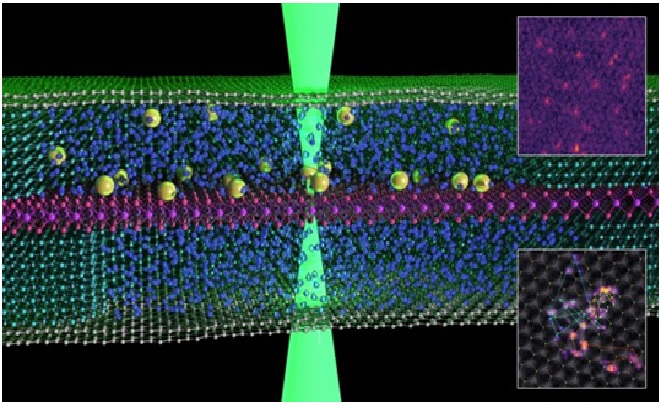First Image of Atoms Swimming in Liquid
The University of Manchester, physicists have created a novel ‘nano-petri dish’ using two-dimensional (2D) materials to create a new method of observing how atoms move in liquid.researchers based at the National Graphene Institute (NGI) used stacks of 2D materials including graphene to trap liquid in order to further understand how the presence of liquid changes the behavior of the solid.

Figure 1: A new method of observing how atoms move in liquid.
Figure 1 shows thatthe team were able to capture images of single atoms ‘swimming’ in liquid for the first time. The findings could have widespread impact on the future development of green technologies such as hydrogen production. [1]
Using transmission electron microscopy (TEM), the team studied how the platinum atoms move around the surface of the material. TEM requires vacuum conditions, so without the construction of the graphene keeping the liquid confined, it would be impossible to study. Vacuum conditions actually change the behavior of the material.
“In our work we show that misleading information is provided if the atomic behavior is studied in vacuum instead of using our liquid cells,” Dr Nick Clark said. “This is a milestone achievement and it is only the beginning – we are already looking to use this technique to support development of materials for sustainable chemical processing, needed to achieve the world’s net zero ambitions.”
The platinum atoms were resting on the internal surfaces and the liquid shifted them at a higher speed than they would without liquid. They also discovered that the presence of salty water led to changes in the atoms' preferred resting site on the surfaces.
The work envisions the cells as a way to produce hydrogen in a sustainable way. Similar cells are used in energy storage and clean water generation, and they could also be used as a proxy for biological systems where liquid and solids interact.[2]
“Given the widespread industrial and scientific importance of such behavior it is truly surprising how much we still have to learn about the fundamentals of how atoms behave on surfaces in contact with liquids. One of the reasons information is missing is the absence of techniques able to yield experimental data for solid-liquid interfaces,” explained Sarah Haigh.
In the experiment, the team suspended a 2D layer of molybdenum disulphide in liquid and encapsulated by grapheme windows. The design provided controlled liquid layers that in turn helped capture videos showing single atoms swimming in the liquid. [3]
References:
- https://www.manchester.ac.uk/discover/news/graphene-scientists-capture-first-images-of-atoms-swimming-in-liquid/
- https://www.iflscience.com/first-image-of-atoms-swimming-in-liquid-captured-64700
- https://gadgets360.com/science/news/atoms-moving-liquid-substrate-image-captured-transmission-electron-microscope-3216969
Cite this article:
Sri Vasagi K (2022), First Image of Atoms Swimming in Liquid, Anatechmaz, pp. 373

